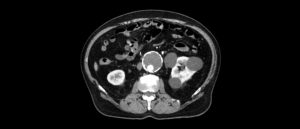Growth prediction of abdominal aortic aneurysms

Scientists at the University of Oxford have, for the first time, devised w In particular, the invention may be used to determine the future progression rate of abdominal aortic aneurysms by using flow mediated dilatation (FMD, a physiological marker of systemic endothelial function) and circulating biomarkers for the prediction of AAA growth.
There are no established biomarkers for AAA progression. This the first time a method has been shown to predict AAA growth with high accuracy. Predicting the future rate of growth of abdominal aortic aneurysms is a particularly useful tool in guiding the management of AAAs as slowly growing aneurysms should receive less frequent monitoring, whereas fast growing aneurysms may benefit from early intervention. Currently the threshold for AAA repair is defined by the size of the AAA and not the biological behaviour of the AAA within the affected individual.
The ability to predict the rate at which an aneurysm will progress will enable stratification of clinical need in terms of monitoring and intervention.
What is an abdominal aortic aneurysm?
The aorta is the main blood vessel that carries blood from the heart to the rest of the body. An abnormal expansion in the abdominal region of the aorta is called an abdominal aortic aneurysm (AAA). When an AAA continues to expand, there is an increased risk of it bursting and this can lead to internal bleeding and in many cases, death. Ruptured AAAs kill approximately 200,000 people in the world each year and of these, 6000 are in the UK.
To prevent ruptures, screening programmes have been implemented in the UK, Sweden, Australia, and Germany – with other countries to follow. In the NHS alone, more than 100,000 ultrasound scans are performed each year for AAA surveillance. However, many of these scans are redundant if we are able to predict the growth of the aneurysm.
AAAs can be treated by surgery but usually this only occurs when an aneurysm reaches a certain size (>5.5cm). It has been shown that aneurysm size alone may not be an absolute predictor of the risk of rupture. Furthermore, the rate of aneurysm progression may vary significantly between individuals and the growth rate of an aneurysm is a good indicator as to whether surgical intervention is required.
In a recent international survey of vascular surgeons, developing novel methods for the prediction of AAA growth was voted as the top priority for research in aneurysms. The method developed by the Oxford team is the first step towards personalised management for patients with AAAs.
about this technology

